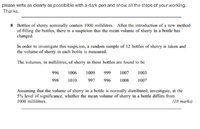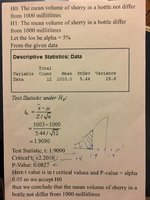resurgance2001
New member
- Joined
- May 1, 2019
- Messages
- 4
I have the question and an answer to said question below.
I am only used to hypothesis testing using binomial distributions. Can someone help
me to understand please how the critical value of T is obtained and how one then uses this to decide whether to accept Ho or whether to reject Ho. I am confused because with all the binomial hypothesis tests it is when the value fall within the critical region that we would normal reject Ho because we are saying that under Ho the particular value found is too extreme, too unlikely, too low a probability so we reject Ho. However, with this question it seems to be reversed. Thanks Peter
I am only used to hypothesis testing using binomial distributions. Can someone help
me to understand please how the critical value of T is obtained and how one then uses this to decide whether to accept Ho or whether to reject Ho. I am confused because with all the binomial hypothesis tests it is when the value fall within the critical region that we would normal reject Ho because we are saying that under Ho the particular value found is too extreme, too unlikely, too low a probability so we reject Ho. However, with this question it seems to be reversed. Thanks Peter


